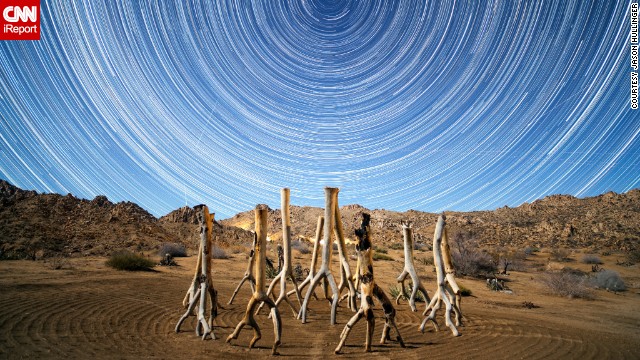 Jason Hullinger went to Joshua Tree National Park last December to catch the Geminid meteor shower. He set up his tripod to take 20-second exposures from about 11 p.m. Thursday to 3 a.m. Friday. He took about 500 photos and combined them with StarStaX, an image stacking and blending software for star trail photography.
Jason Hullinger went to Joshua Tree National Park last December to catch the Geminid meteor shower. He set up his tripod to take 20-second exposures from about 11 p.m. Thursday to 3 a.m. Friday. He took about 500 photos and combined them with StarStaX, an image stacking and blending software for star trail photography.  Gokhan Saymaz is a part-time professional photographer. He created this dazzling image of star trails above Esentepe, in Cyprus. Saymaz used a long exposure technique, shooting 111 frames with a shutter speed of 30 seconds for each frame, before combining them using star trails software.
Gokhan Saymaz is a part-time professional photographer. He created this dazzling image of star trails above Esentepe, in Cyprus. Saymaz used a long exposure technique, shooting 111 frames with a shutter speed of 30 seconds for each frame, before combining them using star trails software. 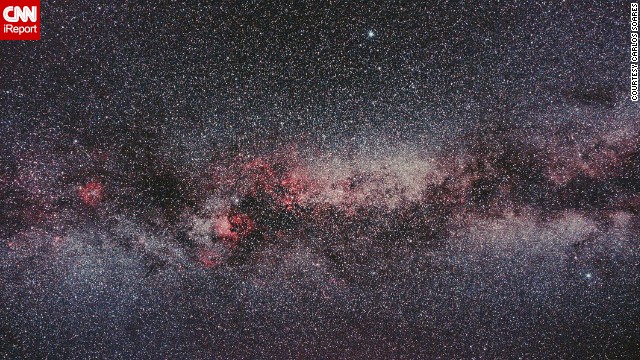 An avid astrophotographer, iReporter Carlos Soares took this photo near the Portuguese city of Braga. "This is widefield astrophotography with many targets, taken with a DSLR camera and a lens. We can see several constellations including Cygnus, the Lyra and the Eagle."
An avid astrophotographer, iReporter Carlos Soares took this photo near the Portuguese city of Braga. "This is widefield astrophotography with many targets, taken with a DSLR camera and a lens. We can see several constellations including Cygnus, the Lyra and the Eagle."  This breathtaking moonrise over the Sahara was taken by Slovenia-based photographer Iztok Medja, while in Morocco. In a former job as a nautical skipper, he would spend many night shifts gazing longingly at the sky. He says that it was while he was away from the light pollution of the city that his passion for night photography emerged.
This breathtaking moonrise over the Sahara was taken by Slovenia-based photographer Iztok Medja, while in Morocco. In a former job as a nautical skipper, he would spend many night shifts gazing longingly at the sky. He says that it was while he was away from the light pollution of the city that his passion for night photography emerged.  Along with several other camera club members, iReporter Allan Qua Borebor made his way to one of the piers in Caramoan, in the Philippines, at around 11 p.m on June 30th. "The place was so quiet, so serene and so dark ... We were so lucky because a thousand stars showed up," Borebor recalls. "It was a perfect night together with friends."
Along with several other camera club members, iReporter Allan Qua Borebor made his way to one of the piers in Caramoan, in the Philippines, at around 11 p.m on June 30th. "The place was so quiet, so serene and so dark ... We were so lucky because a thousand stars showed up," Borebor recalls. "It was a perfect night together with friends." Sarah Thornington is a Massachusetts-based iReporter who fell in love with the vast expanse above from a young age. On June 27, she picked up her camera and headed to the local drive-in. The night had all the conditions for a perfect shoot and Thornington watched as a couple of shooting stars (seen at the top of the image) blazed across the sky. She is already thinking about her summer stargazing bucket list -- to get "that beautiful shot of the Milky Way as it rises over the ocean." 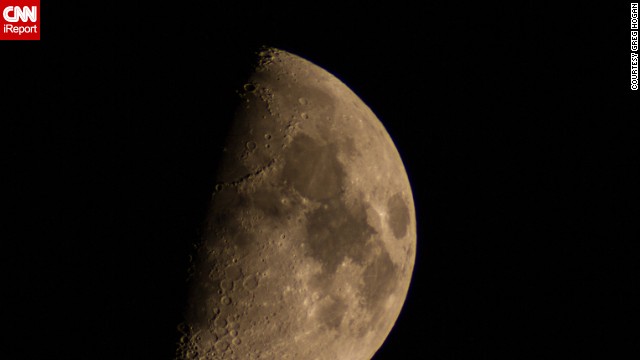 Greg Hogan may only have been aiming his camera at the sky for the last six months but the astrophotography bug has bitten him pretty hard. "I bought a telescope for $25 at a yard sale and the first time I saw Saturn's rings, I was completely hooked," he says. "There's just so much out there that people don't realize that you can see without the equipment being expensive if you just slow down a minute and take a peek."
Greg Hogan may only have been aiming his camera at the sky for the last six months but the astrophotography bug has bitten him pretty hard. "I bought a telescope for $25 at a yard sale and the first time I saw Saturn's rings, I was completely hooked," he says. "There's just so much out there that people don't realize that you can see without the equipment being expensive if you just slow down a minute and take a peek." 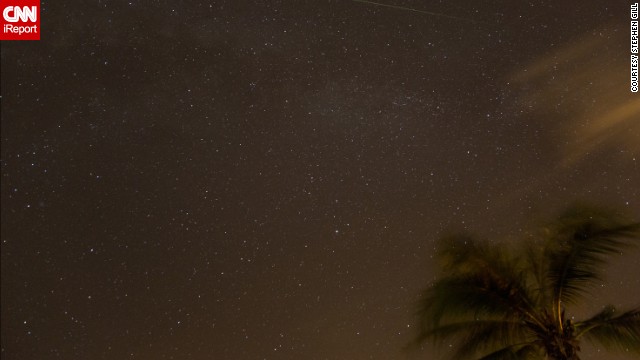 Stephen Gill who loves "science, space and all things tech-y," captured this photo while vacationing in Grand Cayman with his wife on August 13 last year. "I've been out three nights in a row trying to capture a Perseid (meteor shower) since the conditions here are amazing, and finally got lucky," he said.
Stephen Gill who loves "science, space and all things tech-y," captured this photo while vacationing in Grand Cayman with his wife on August 13 last year. "I've been out three nights in a row trying to capture a Perseid (meteor shower) since the conditions here are amazing, and finally got lucky," he said. 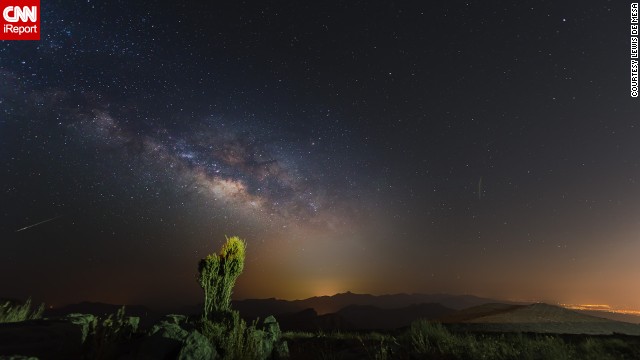 An enthusiastic stargazer, 39-year-old Lewis de Mesa wasn't going to miss an opportunity to snap the Camelopardalids meteor shower in May this year. Standing atop the highest peak in the United Arab Emirates, de Mesa snapped this impressive shot but wasn't thrilled by the result. "Not so much luck here in the United Arab Emirates," he said. "It wasn't that great ... Good thing I got some Milky Way goodness."
An enthusiastic stargazer, 39-year-old Lewis de Mesa wasn't going to miss an opportunity to snap the Camelopardalids meteor shower in May this year. Standing atop the highest peak in the United Arab Emirates, de Mesa snapped this impressive shot but wasn't thrilled by the result. "Not so much luck here in the United Arab Emirates," he said. "It wasn't that great ... Good thing I got some Milky Way goodness."
- The Geminid meteor shower will be most visible in the night sky over the weekend
- Geminids are debris from an extinct comet called 3200 Phaethon
- The meteor shower can be seen more easily from a dark area, away from city lights
Planning to catch the meteor shower this weekend? Share your best shots with CNN iReport
(CNN) -- Amid the twinkling holiday lights adorning homes around the world, a natural light show is set to take center stage over the weekend.
The Geminid meteor shower has been visible in the night sky this week, with the best opportunities for viewing to come on Saturday night.
Geminids are debris from an extinct comet called 3200 Phaethon, which was previously believed to be an asteroid, according to NASA.
"Basically it is the rocky skeleton of a comet that lost its ice after too many close encounters with the sun," NASA said on its website.
The light show comes around annually in mid-December, when the Earth encounters detrius from 3200 Phaethon, "causing meteors to fly from the constellation Gemini."
Space enthusiasts consider the light show to be one of the clearest and best to watch.
"Though the moon was nearly full, the Geminid meteor shower is known for having some very bright and slow moving meteors which are visible against the star trails taken near Joshua Tree National Park," iReporter Jason Hullinger wrote last year after photographing the phenomenon with a time-lapse camera.
The meteor shower can be seen most easily in the Northern Hemisphere in areas with dark skies, away from city lights.
"The Geminids are expected to peak just before dawn on Dec. 14," NASA said, "with a predicted peak rate of 100 to 120 meteors per hour."
NASA is hosting a Web chat about Geminid on Saturday evening from 10 p.m. to 2 a.m. CDT.
Slooh.com will present live visual and audio feeds of the meteor shower Saturday night.
No comments:
Post a Comment